Coaches usually have their breakthroughs in the countries they were born in, sometimes even for their hometown club.
For some coaches, it is the country they have played the majority of their career in, like Mikel Arteta and England.
For Uwe Rösler, it is nothing like that.
The former striker was born in East Germany and grew up playing in the closed-off country.
After Germany’s reunification in 1990, Rösler went off to have a decent career in the Bundesliga before making a transfer to England, playing for the likes of Manchester City and Southampton, making 102 appearances in the Premier League and becoming part of the Citizens’ Hall of Fame.
Personal health struggles unfortunately led to the end of his playing career.
After his recovery, the opportunity to work with the club as a coach opened up, which started off his long coaching career in 2005.
After multiple years in Norway at clubs like Lilleström, Viking and Molde, he went on to coach in England at clubs like Brentford, Wigan Athletic and Leeds United.
After his stint in England, he went on to become the manager of Malmö FF in Sweden and helped the club qualify for the UEFA Champions League.
In 2020, 15 years after making his managerial debut, Rösler finally got his first and only job in Germany, coaching Fortuna Düsseldorf for 53 games.
Since July of 2022, Rösler has now been the Head Coach of Aarhus GF.
The club had stabilised itself in the top half of the league, and currently, Rösler has his men sitting in third place in a tight Superliga title race, only losing to the big clubs FC Copenhagen and FC Midtjylland.
In this tactical analysis and head coach analysis, we will analyze Uwe Rösler’s tactics and principles, which he has brought to Aarhus, and explain why they have been so successful this season.
Uwe Rösler Tactic #1 – Width & Presence In The Final Third
Aarhus is not just sitting in a very decent third place right now; they are also tied with Viborg and Midtjylland for first place in goals scored in the league.
They are not just a force in attack.
With only 13 goals conceded, Rösler and his men have conceded the fewest goals in the Superliga, even better than teams like Copenhagen or Randers.
For this piece, we are going to examine what makes Aarhus so dangerous in attack, showcasing some tactical principles that Rösler, a former striker, has incorporated into his playing style.
What stands out about Aarhus’ attack is that it is the highest-scoring in the league, with only eight attempted shots per game.
This leads to Aarhus only ranking average in expected goals created in the Superliga, but they have the third-best value in terms of expected goals per shot.
This simply means that Aarhus does not often shoot at goal, but when they do, those shots are from very dangerous positions.
Aarhus are one of the teams that like to dominate possession in the Danish league.
They average 54.9% of possession per game, ranking fourth in the league and on par with league leaders FC Copenhagen.
This means Rösler and his men face deep blocks rather often, and we are going to examine their first big and vital principle to see how they still create big scoring chances against these types of defences.
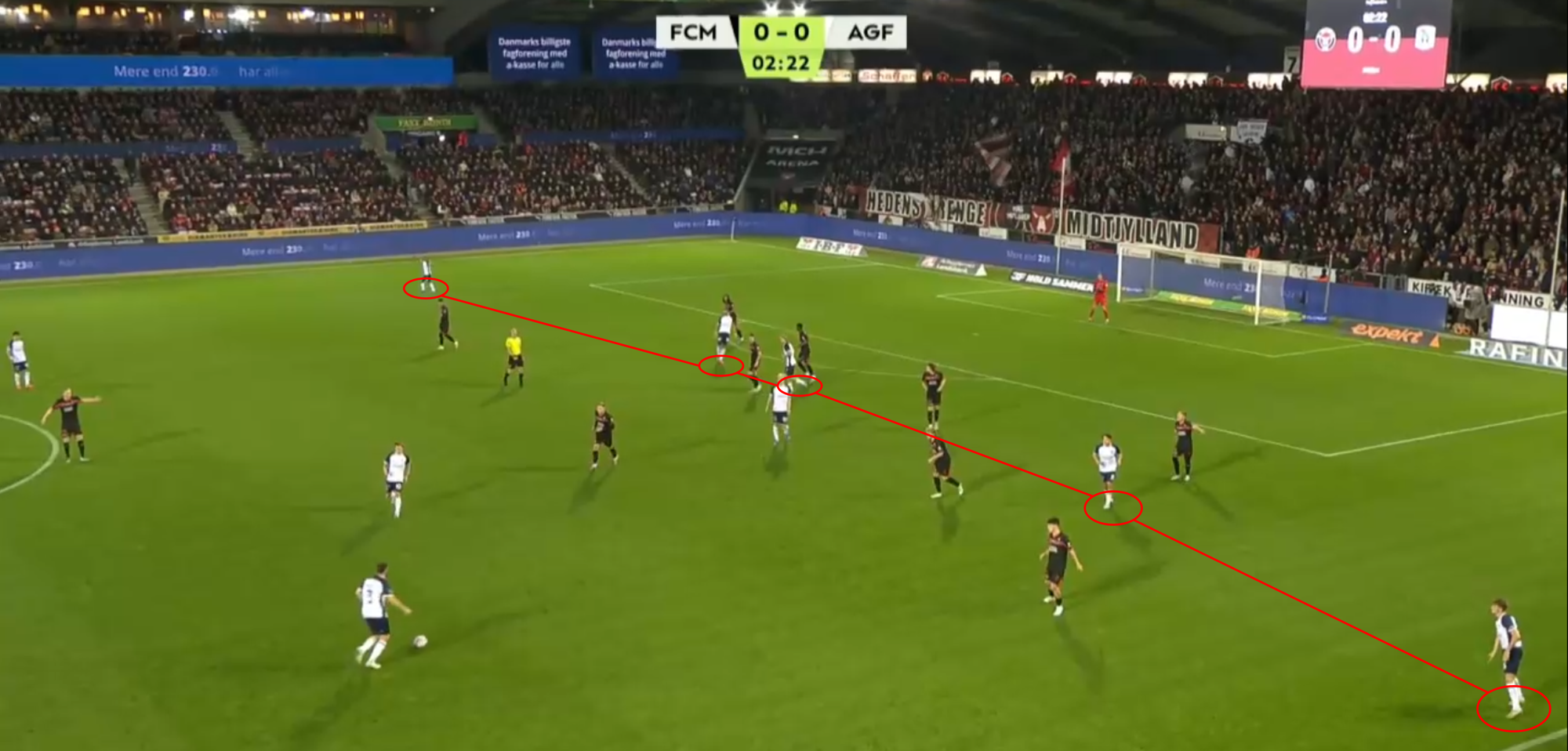
In every single game this season, Uwe Rösler’s formation has been a 3-5-2 setup.
In the build-up, Rösler has his middle centre-back drop back a bit and has his outside centre-backs push up the field in the half-spaces.
From then on, Rösler prioritises two things: He wants a presence in the middle of the pitch, which he obviously achieves by playing with two strikers, but he also wants to stretch out the opposing defence and, therefore, have some width.
In attack, Aarhus’s full-backs push up the field in a very wide position.
The near-sided full-back is always close to the sideline, and the far-sided full-back also does not push inwards but stays outside.
In the middle of the field, the two strikers and one near-sided midfielder always position themselves in the opposing backline, forcing them to defend the centre of the pitch.
While most defences in a deep block always prioritise the middle of the field, this forces the opposing team’s block to stretch out a bit and overload the centre.
The defenders constantly have to be aware of the players in the middle of the field while still having to at least eye the high full-backs, resulting in difficult decisions.
Rösler always wants five players upfront in his most advanced line, therefore creating a mismatch against the usual back-four that most teams in the Superliga play.
It’s just a numbers game here, with only four defenders in the backline and five attackers in the attacking line, one of them always should be open to receive the ball.
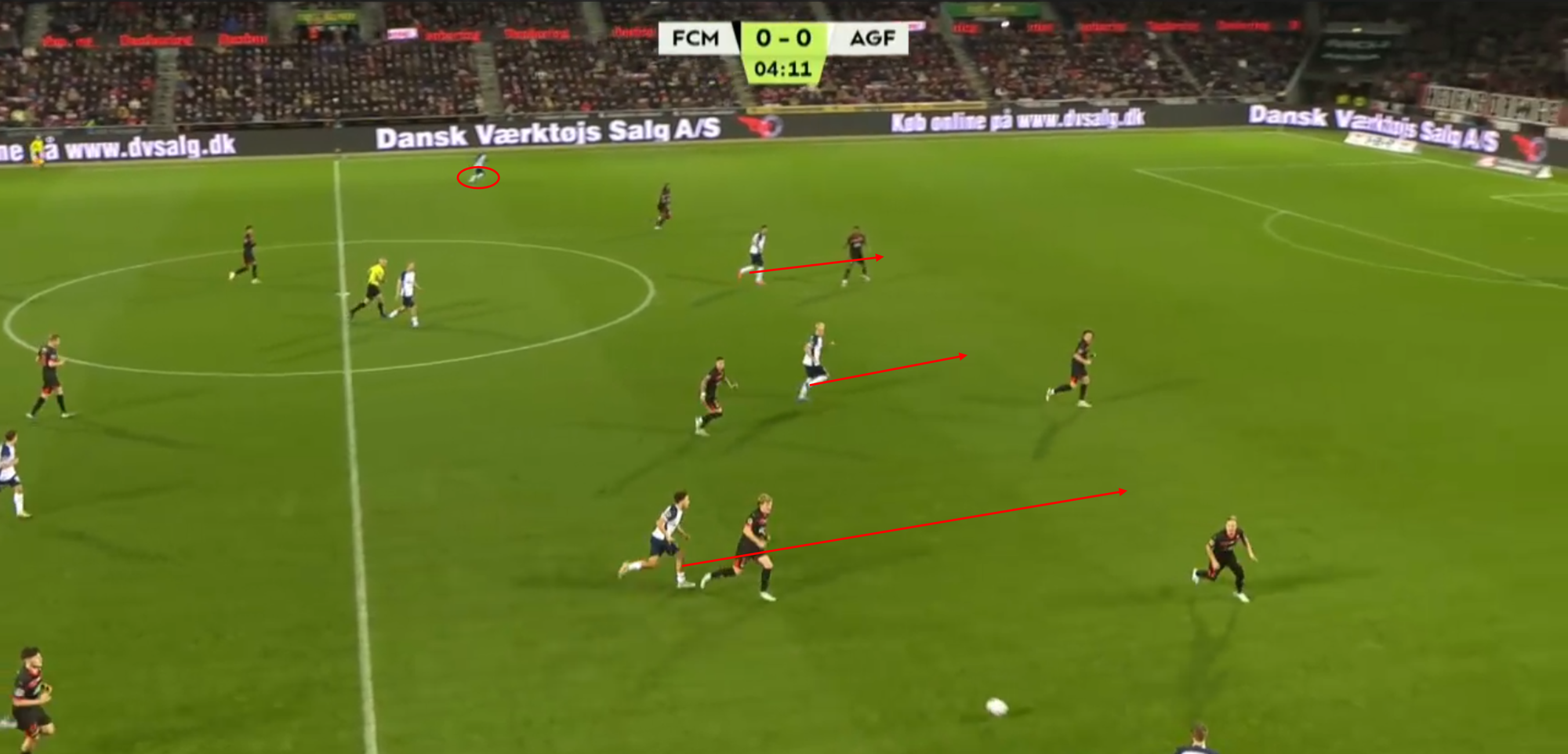
Here, we can see a counterattacking situation for Aarhus, and they are still applying this principle.
Both full-backs are really wide; even the far-sided one and three players in the middle of the field are making runs towards the gaps between the defenders to get in behind the defensive line.
This tactical principle is visible in every possession by Aarhus and allows them to attack effectively, keep possession, and establish ball security if needed.
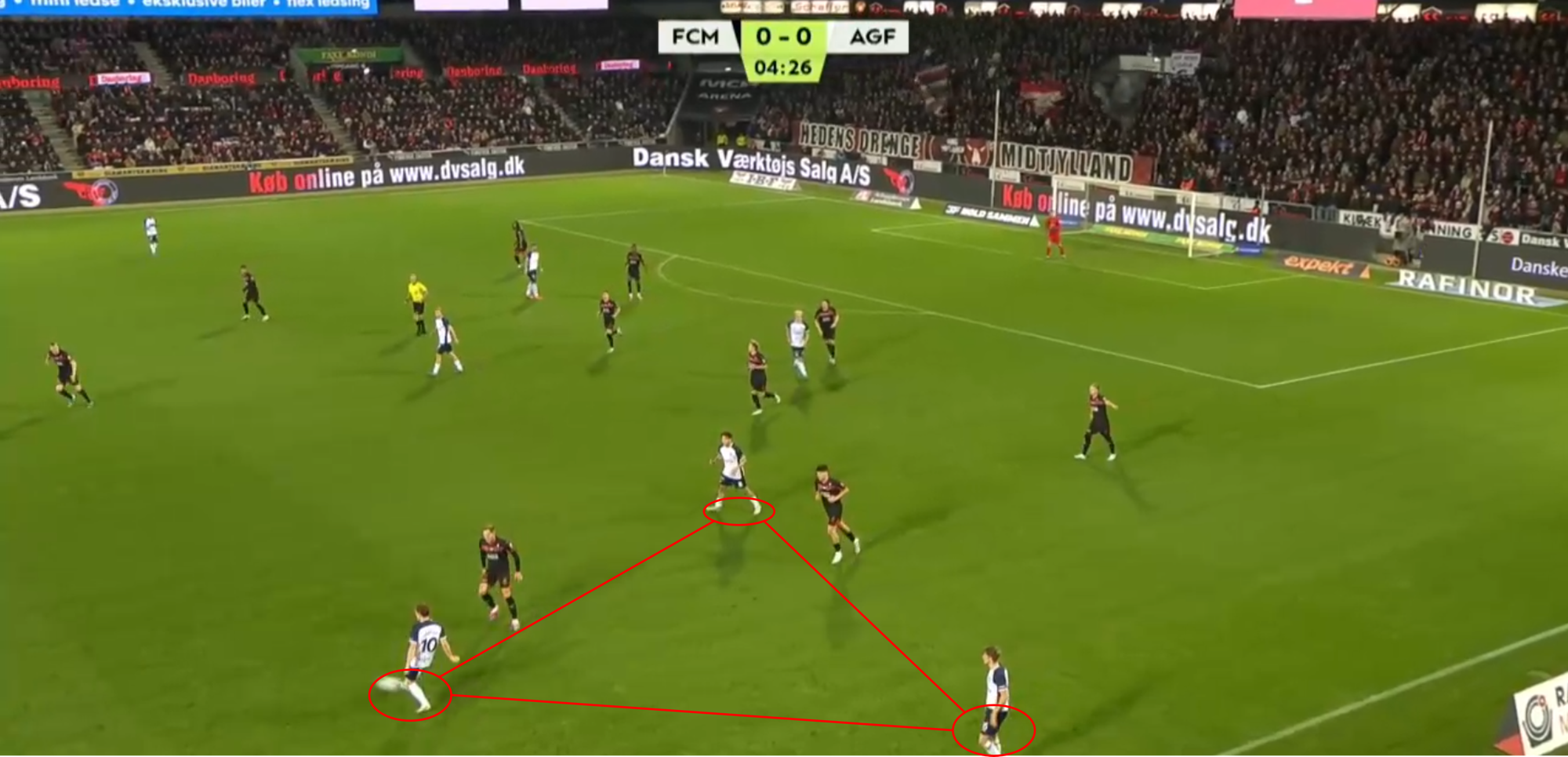
In this situation, the counter did not end the way Aarhus wanted, so they tried to establish possession instead.
Once again, both full-backs are very wide, but the near-sided midfielder and full-back drop back deep to create a triangle on the wing and a passing option for the defenders.
This allows very quick ball circulation and helps the team build up its game while still occupying the opposing deep block, making it very hard to press them effectively.
While we are looking at the play in possession right now, it also allows for a very good rest defence with good spacing of players and many players in the middle of the field, ready to engage in counter-pressing or dropping back and defending the middle of the field.
Aarhus also has the most crosses in the Superliga so far this season because it always manages to free up its players in space on the wings and then has a great presence in the box, making it hard for opposing defences to pick up all the players.
Uwe Rösler Tactic #2 – Overload & Switch
Now, we have talked a lot about what Uwe Rösler has his men do when they are building up their play from the second line in a more advanced position, and that is for sure the key part of their game, but one question remains: How do they even get into this advanced position?
Sure, sometimes teams just drop back into a deep block against Aarhus because they know their attacking power, but still, many teams are trying to put pressure on them, starting with the build-up.
We saw Aarhus’ positioning when trying to establish possession earlier, but we will take another look at it here.
What’s important to understand is that Aarhus is still trying to maintain its first principle, so its build-up in the first line can not hamper the principle it needs when it advances the ball.
This means that Aarhus still has its two strikers pushing forward and its full-backs in wide positions, guaranteeing a smooth transition between phases of possession for the team.
Therefore, Rösler had to find some solutions to progress the ball within these limitations, and the solution is relatively simple.
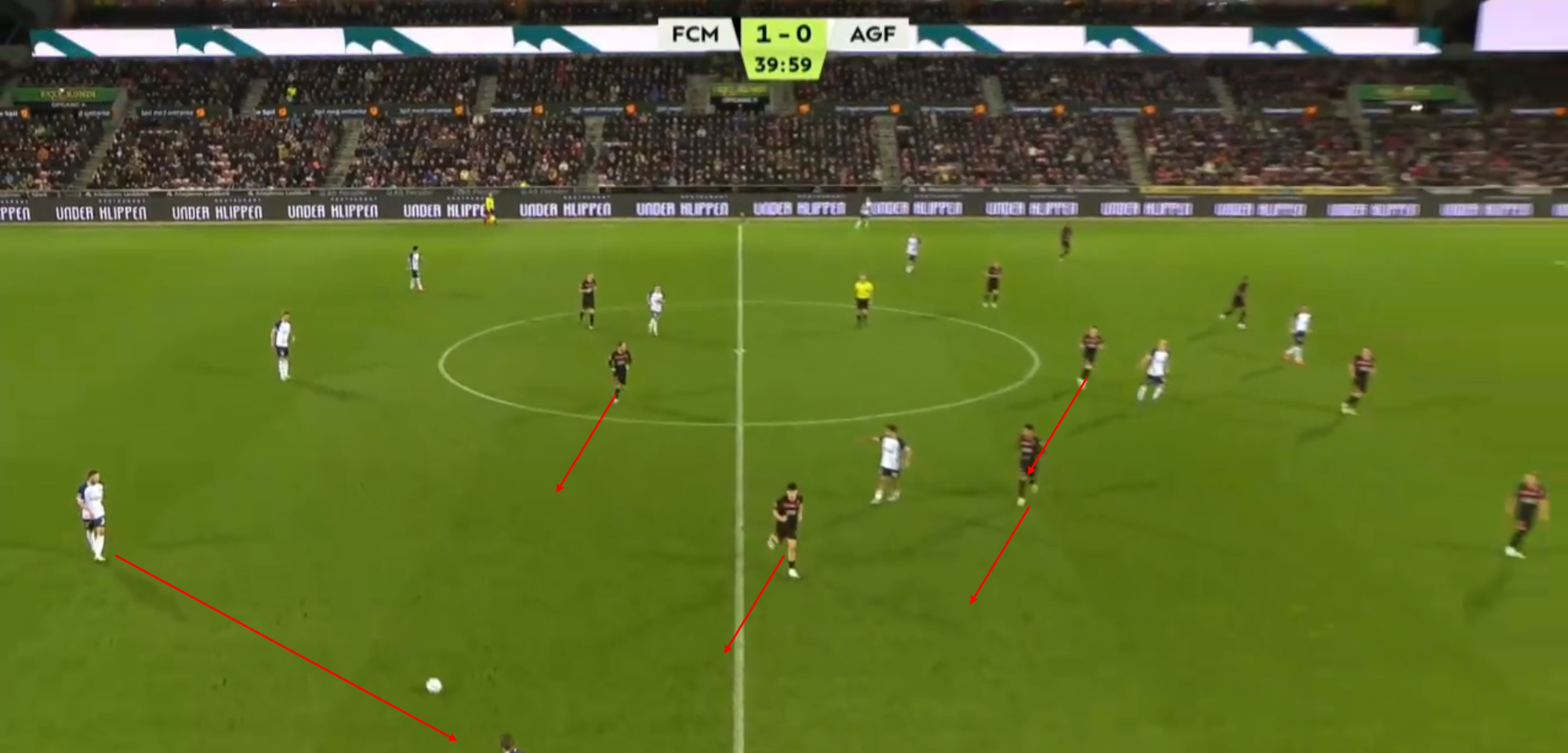
Rösler has his men trigger play with a pass from one of the two outside centre-backs towards the near-sided full-back, who drops into a deeper position to receive the ball.
If we look at the usual press in modern football, this not only triggers play for Aarhus but also triggers the press of their opponents.
In the picture above, we can see FC Midtjylland pressing the ball outwards to the full-back.
This means Midtjylland is ultimately pushing towards the right side of Aarhus, trying to put pressure on the full-back.
This is precisely what Aarhus wants; however, attracting the press to one side is one of the easiest ways to create space.
While many teams would now try to overload the right side of the field and find a solution in condensed space, Aarhus does something completely different.
The right-back Andersen holds on to the ball until the press reaches him and then simply plays a backwards pass back to his centre-back.
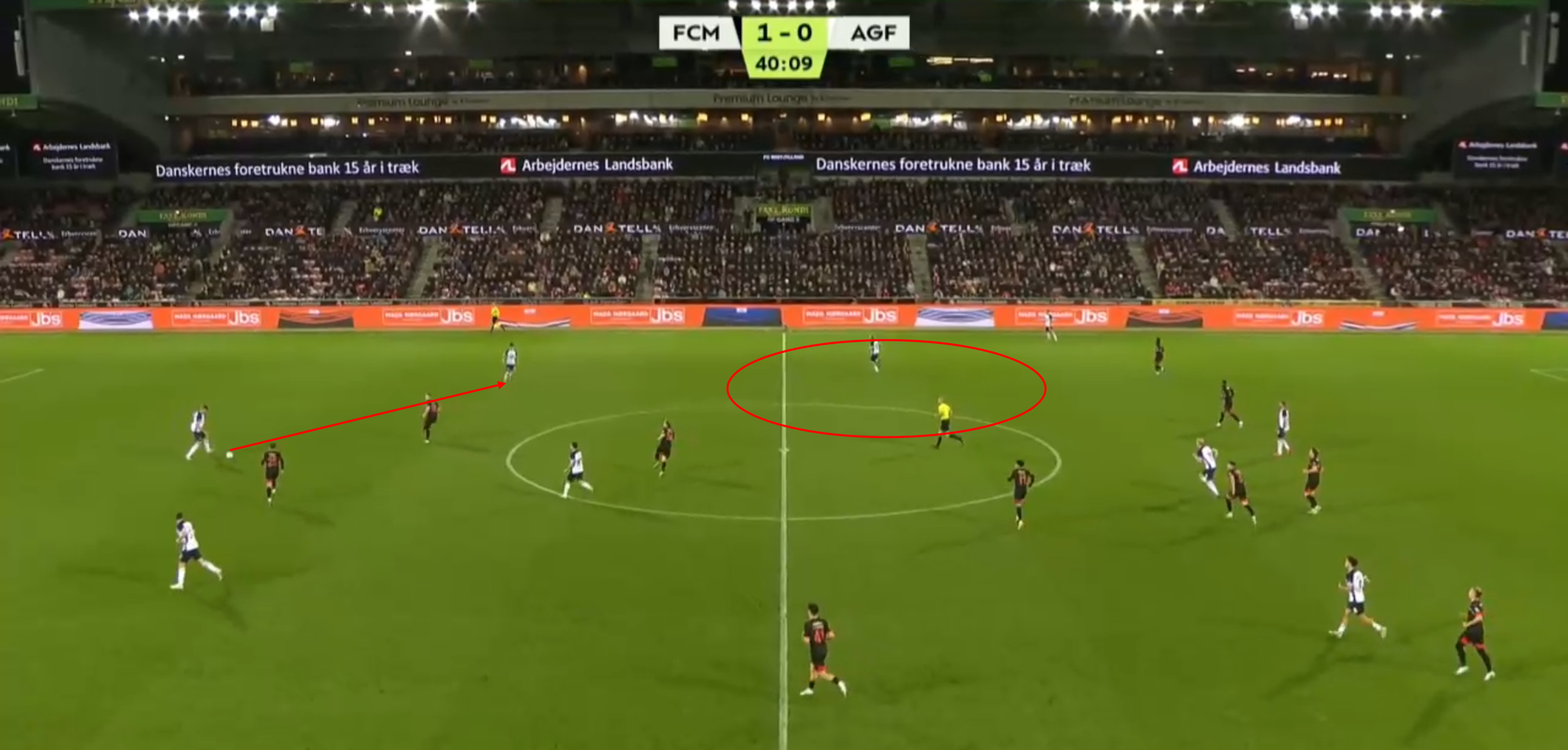
This drags out the press even more, with both Midtjylland strikers trying to press Aarhus’s backline now.
Once again, Rösler simply lets the numbers do the job for him.
Two strikers against three defenders always creates a numbers advantage for Aarhus in their first line of play and with their holding midfielder dropping back deep as well, they are in a very good position to control the game from there.
Because they attracted Midtjylland to their right side earlier, the left side now has acres of vacated space.
Aarhus now needs to switch play from their right to their left flank quickly, and they are doing so by switching play through their backline.
The middle centre-back receives the ball from the right centre-back and plays it towards the left centre-back.
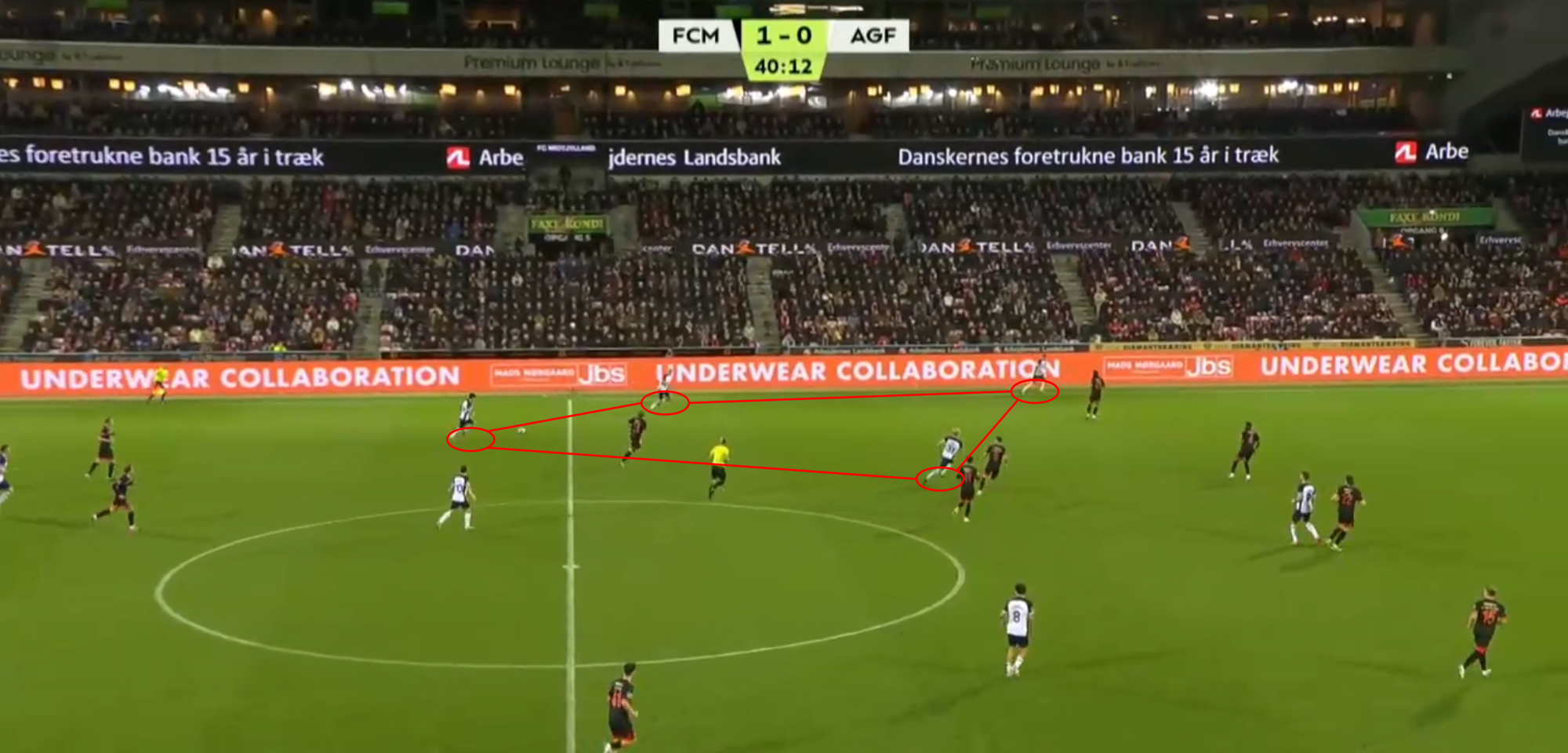
The left centre-back, Eric Kahl, now has a lot of space in front of him. He uses his first touch well to dribble into that space and advance the ball into the second line of build-up.
In this situation, Aarhus creates a diamond on the wing to secure the ball progression into the opposing half, giving Kahl two easy passing options and, once again, allowing the team to establish possession in the opposing half.
By attracting the press and switching play with just two passes, Uwe Rösler’s style of play has given his team an easy solution to progress the ball while still applying their basic principle of play and getting them into position to use their strengths quickly.
Uwe Rösler Tactic #3 – Deep Vertical Passes
So far this season, we have examined the basic principles that Aarhus and Rösler use to get into favourable positions.
Still, we have not examined how they actually convert their positional play into goalscoring opportunities.
We have already established that Aarhus plays a lot of crosses into the box, especially the six-yard box.
Still, crosses are kind of boring, and Rösler and his men also use different ways to create opportunities.
While having five players in the attacking line creates a numerical advantage, it also limits the number of passing options for their teammates with the ball, which can cause the game to become very static.
To get the opposing defences moving, Aarhus is using different ways of movement in their attacking line.
Obviously, because of the offside rule, you can’t really move forward when you’re at the same height as the opposing backline, so they have to find solutions by dropping players deep out of the line.
Another problem is facing a back three because with the wingbacks dropping back, they can create a 5v5 situation.
Let’s take a look at what Rösler has his men do in these situations.
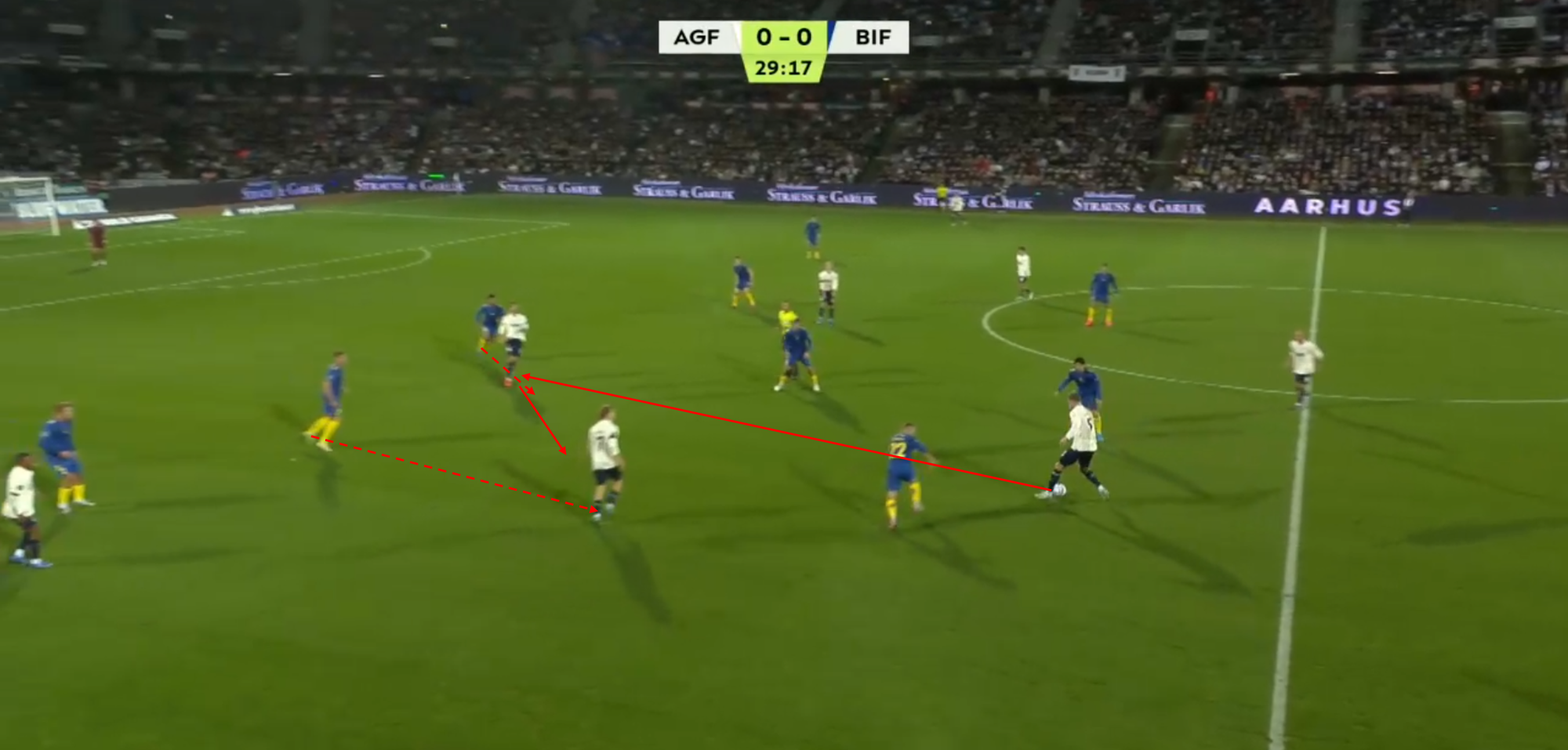
Here, we can see how Rösler wants his team to play in an ideal situation against a back-five.
The first thing that happens is that the player in the left half-space drops back into the midfield, pulling away from the centre-back and marking him.
Both players on the wings stay wide and high, forcing the full-backs to stay outside.
Shortly after the first player drops back, one of the two strikers drops back as well, but not as far as the first player.
From there on, the centre-back has an easy vertical pass, and the striker can play an easy lay-off, progressing the ball and keeping the block moving.
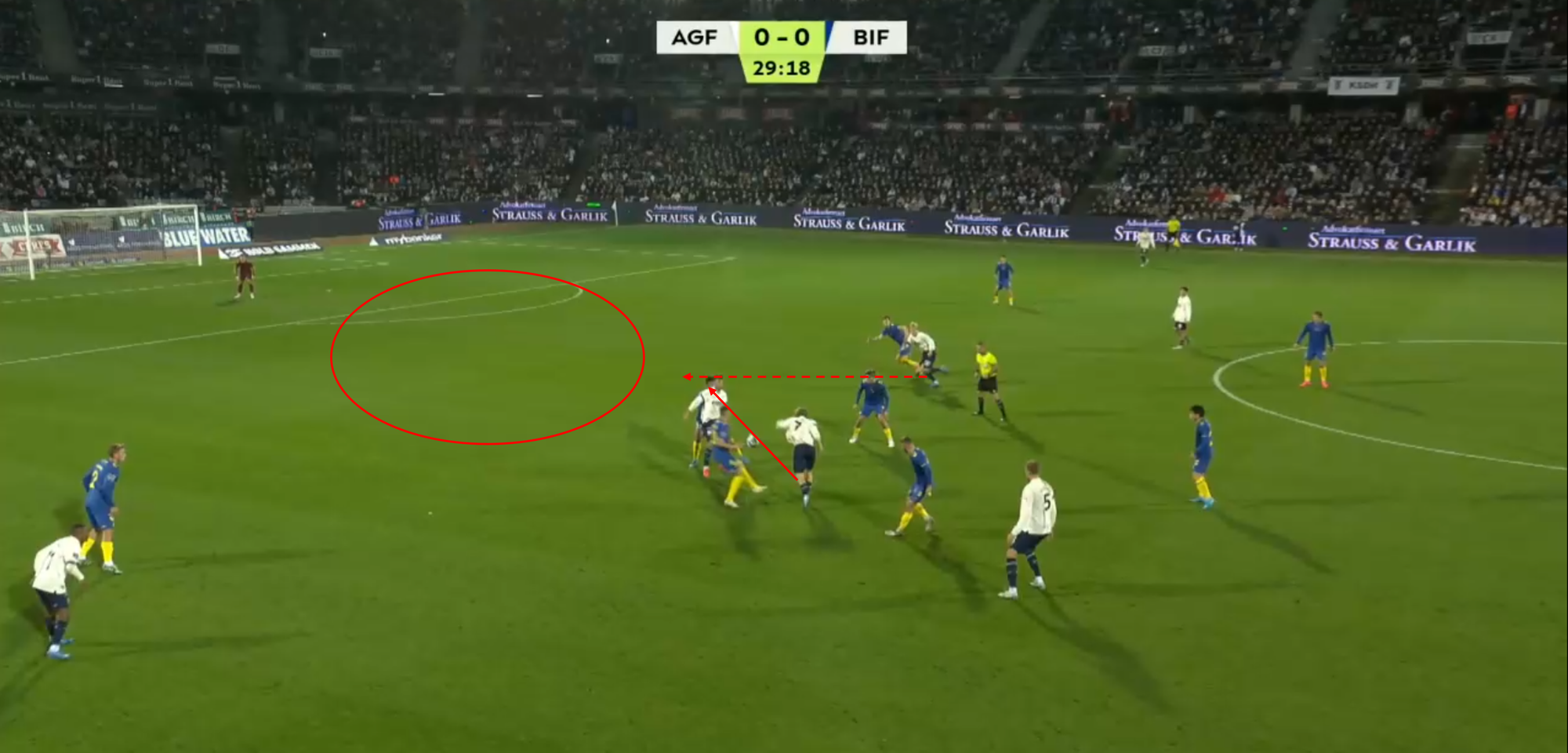
With the defenders forced to step up but the full-backs staying out wide, Aarhus created a window for a through ball behind the centre-backs and the backline.
The full-backs were too deep to play an offside trap.
From there on, all Madsen has to do is play a pass towards Bech, the far-sided striker.
He starts his run behind the defensive line, slipping into the back of the defender, who pushes out of the line to follow his striking partner, Mortensen.
This gives him the advantage against his marker, and he managed to get in behind the defensive line.
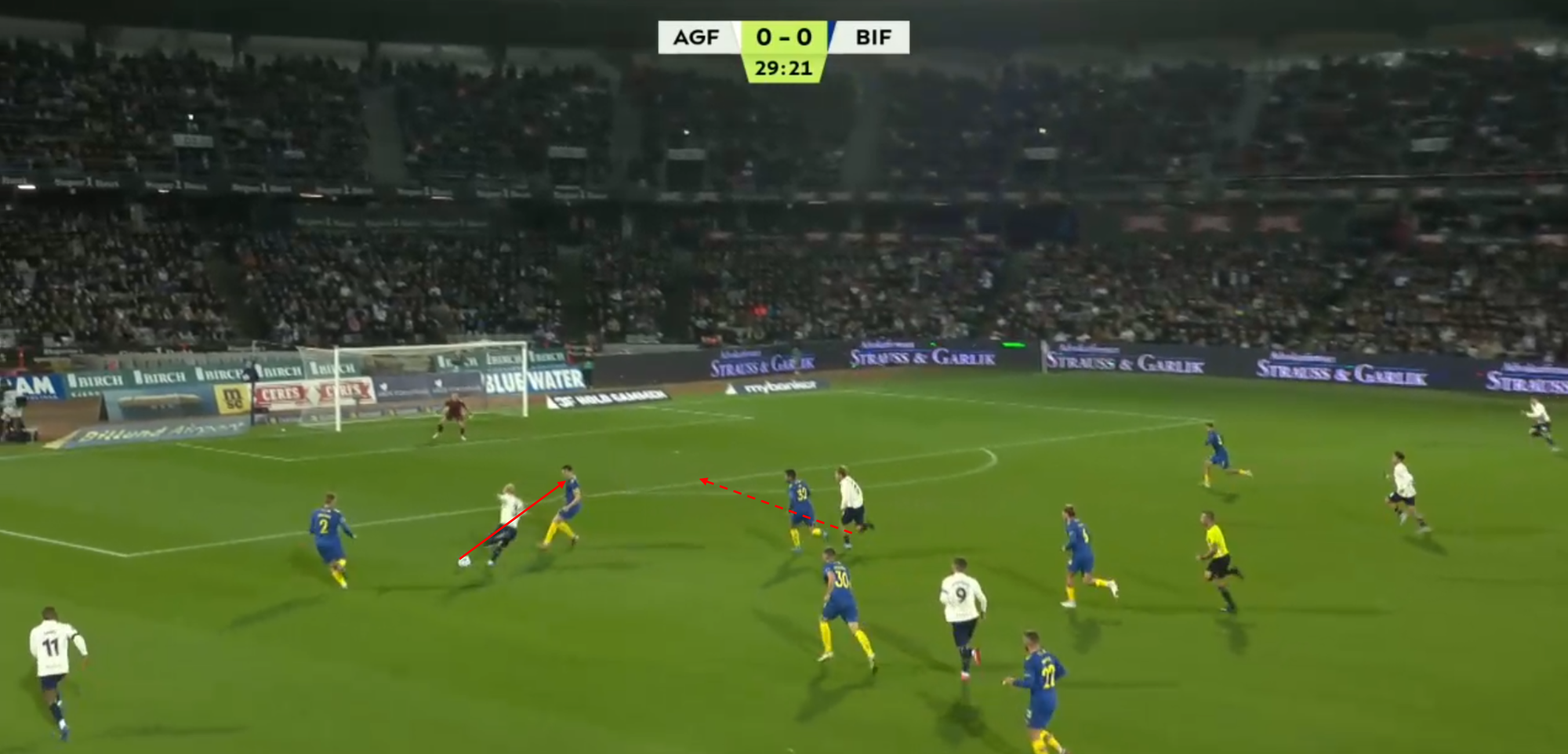
Even though the through ball was less than ideal, Aarhus still managed to create enough confusion and chaos in the backline to create a chance by squaring the ball one more time.
In the end, the opposing defender blocked the shot with his hand, resulting in a penalty and the winning goal for Aarhus—a result of simple movements and simple passes executed so well that it was really hard for the opposing team to defend.
Conclusion
Aarhus GF have had an exciting and strong development in recent years.
After getting promoted back to the Superliga 10 years ago, the club established itself in the top half of the league rather quickly and has been extremely stable under German Head Coach Uwe Rösler for the past two-and-a-half years.
While under Rösler’s predecessor Nielsen, the playing style was heavily influenced by an underdog mentality and a lot of heart and fight, Rösler has managed to develop the team in possession as well, making Aarhus an actual top team in the Superliga.
This season, the team has only lost two games against national giants FC Copenhagen and league-leading FC Midtjylland, but otherwise has been incredibly dominant.
The loss to Midtjylland has been costly, however, because it gave Aarhus a chance to jump to the top of the standings, which they failed to convert.
Right now, the team is struggling a bit with close games, having a stretch of multiple draws in games they should have won, and it is costing them in the title race.
But, obviously, the regular season in Denmark does not decide the champion, the teams will need to be ready come play-off time in Spring.
Right now, Uwe Rösler’s coaching style has his Aarhus team on the right track.
If they can stay close to the top two teams, the club has a realistic chance to win its first championship in nearly 40 years.

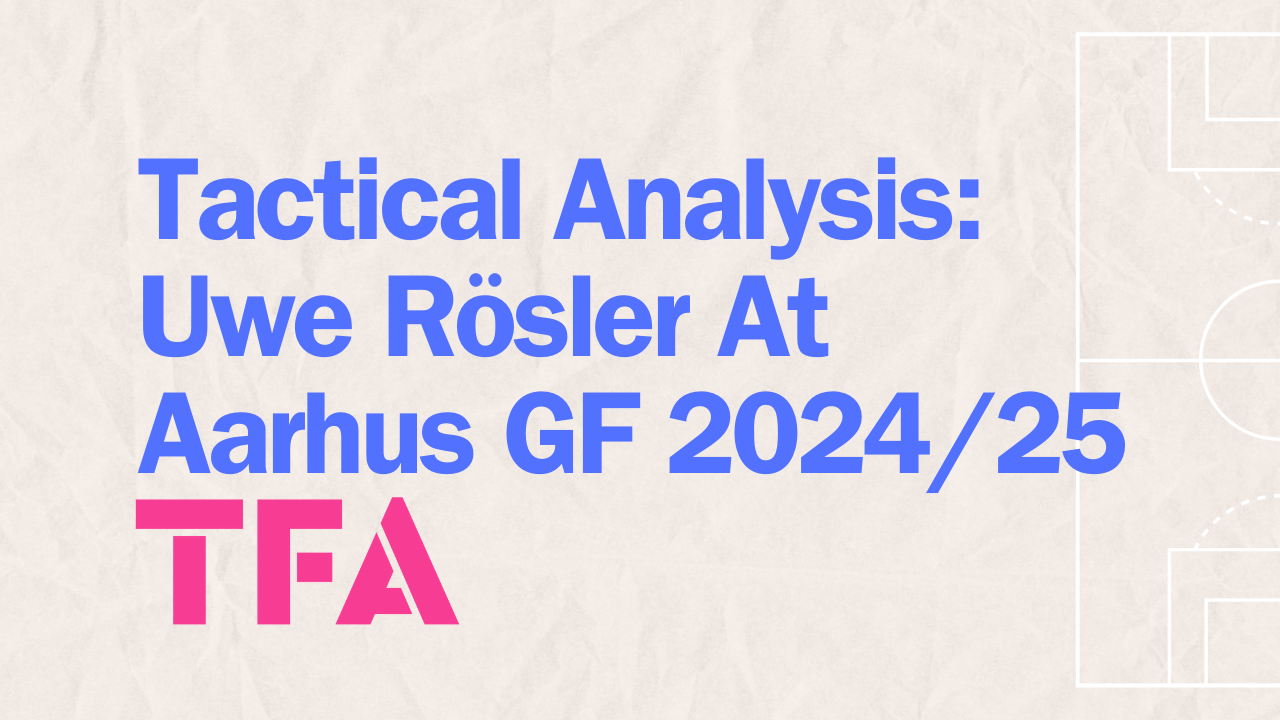




Comments